Did you know 62% of diners search for restaurants on Google? Are you still ignoring your restaurant SEO?
Unless your restaurant appears on the first page of Google for local searches, how will your customers find you?
Bringing your restaurant in front of your customers, especially when they’re browsing for one, is a challenging task. (Wish you had Harry Potter’s magic wand in your hand.)
But, Google does give you a magic wand, which may not yield instant results, but with time, it shows your restaurant on the first page of search engines – restaurant SEO.
With 46% of Google searches occurring for local businesses, if you’re not optimizing your website for search engines, you’re throwing away your customers to competitors.
In this article, Search Engine Publication outlines the importance of restaurant SEO and explains these eight tips to improve your online visibility with restaurant SEO.
Does restaurant SEO matter?
SEO for your restaurant directly impacts your online visibility, helps you attract more diners, and enhances your website’s reputation. In the digital era, where diners predominantly use search engines to gather information about restaurants and other eating joints, ensuring your restaurant website ranks high in the search results is necessary.
Here’s a look at the number of searches that occur related to restaurants:
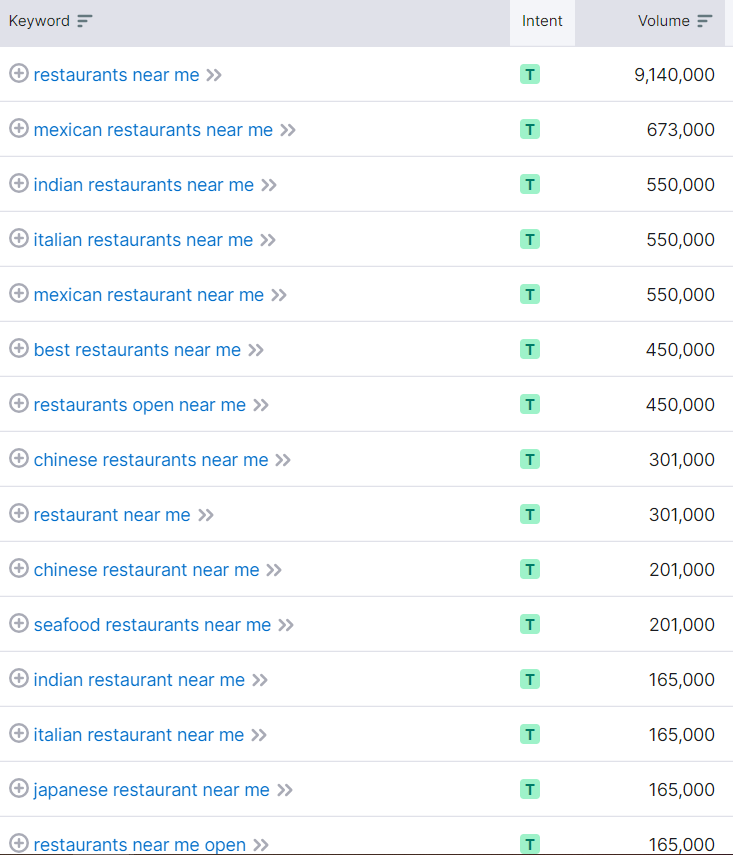
Look at the number of people who search for “restaurants near me.” Your customer just types this search query, and based on their location, Google suggests some top restaurants. Google or any other search engine suggests restaurant websites that are optimized for local SEO.
So, when creating your website, including the local search keywords makes it more accessible and relevant to search engines. This increases the likelihood of being discovered by potential customers.
8 SEO tips for restaurants
Now that you have seen the number of searches performed by customers when searching for a website, let’s explore some search engine optimization tips for your restaurant:
1. Carefully plan your keywords
Let’s assume you have a bakery in San Fransico,
The initial step you take is to create a search engine optimization plan with keyword planning.
Keyword planning involves identifying the specific search terms you desire your bakery to rank for. These could be “pastries,” but as it’s a difficult keyword to rank for, look for other relevant keywords to increase your chances of ranking on the search engine result pages. This could include “best pastry in San Francisco.”
Using keyword planning tools like Google Keyword Planner and SEMrush, you can find low keyword difficulty (KD) words that don’t take time to rank on search engines.
When researching keywords, it is advisable to categorize your targets into three types of keywords:
- High-intent general bakery terms
- Niche keywords
- Branded keywords
- High-intent general bakery terms: These are broad but valuable keywords such as “bakeries in San Francisco,” “best San Francisco bread shop,” “great bakeries in San Francisco,” and so forth.
- Niche keywords: Niche keywords are specific to what your bakery offers. Consider searches such as “San Francisco sourdough bread,” “gluten free bakery San Francisco,” and “stella pastry San Francisco”.
- Branded keywords: This involves optimizing for the name of your bakery and related keywords. It’s not uncommon for bakeries to not hold the first few results for their bakery name and instead have Yelp appear in that first slot.
List out the terms you deem most impactful for your bakery to appear in search results – and then validate that people are searching for these terms using the keyword planning tool.
Next, draft a list of potential customers visiting your bakery. This helps you identify their pain points and search for keywords specific to this demographic.
Here is an example of a San Francisco bakery:
| Potential customers | Potential keywords |
| Parents buying birthday cake | “best birthday cakes San Francisco” “custom birthday cakes” |
| Health-conscious individual | “gluten free pastries San Francisco” “Vegan Bakery San Francisco” |
| Office worker looking for coffee and pasty | “pastries San Francisco” “best coffee shop San Francisco” |
Again, you should then compare terms in keyword research tools to ensure you’re optimizing for keywords that are actually being searched.
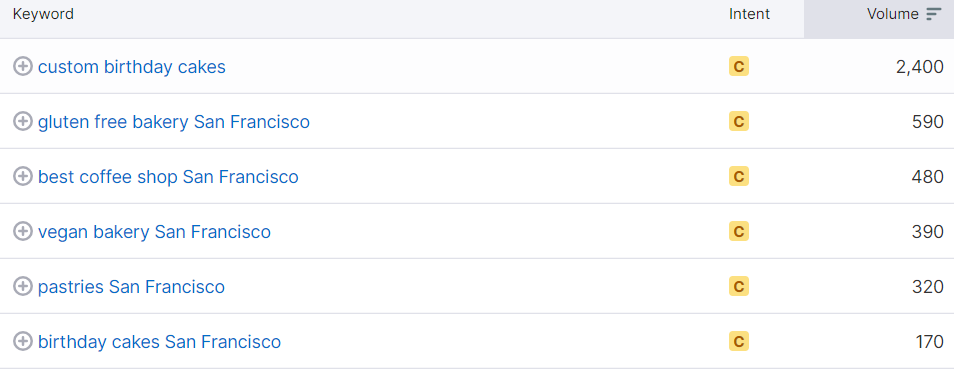
As a rule of thumb, any search volume above 50 is considered good enough to include as your keyword.
Through proactive planning, you create a foundation of keywords to concentrate your efforts on, which deliver real value to your business.
2. Set up your Google Business Profile
Setting your Google Business Profile is a must for restaurant owners.
Your business profile is available to customers who search for your restaurant. It gives information about your website, menus, operational hours, and location. Integrating with Google Maps provides navigation.
Here are the steps to properly set up your profile:
- Provide accurate information: Specify the link to your restaurant website, menus, contact information, and business hours. Ensure that all resources have accurate and up-to-date information.
- Mention your menu URL in the “Info” tab: This allows customers to learn more about your food before they visit you.
- Update your mobile listing: If your restaurant menu items appear on the mobile version of your Business Profile, ensure that the item names and prices are current.
- Utilize LocalSync: This tool can be a lifesaver for keeping your information consistent across multiple platforms. With LocalSync, when you update information such as menus, hours, and location on your website, it automatically updates the same on your Google Business Profile, Foursquare, and Facebook.
Here’s an example of what a business profile looks like:
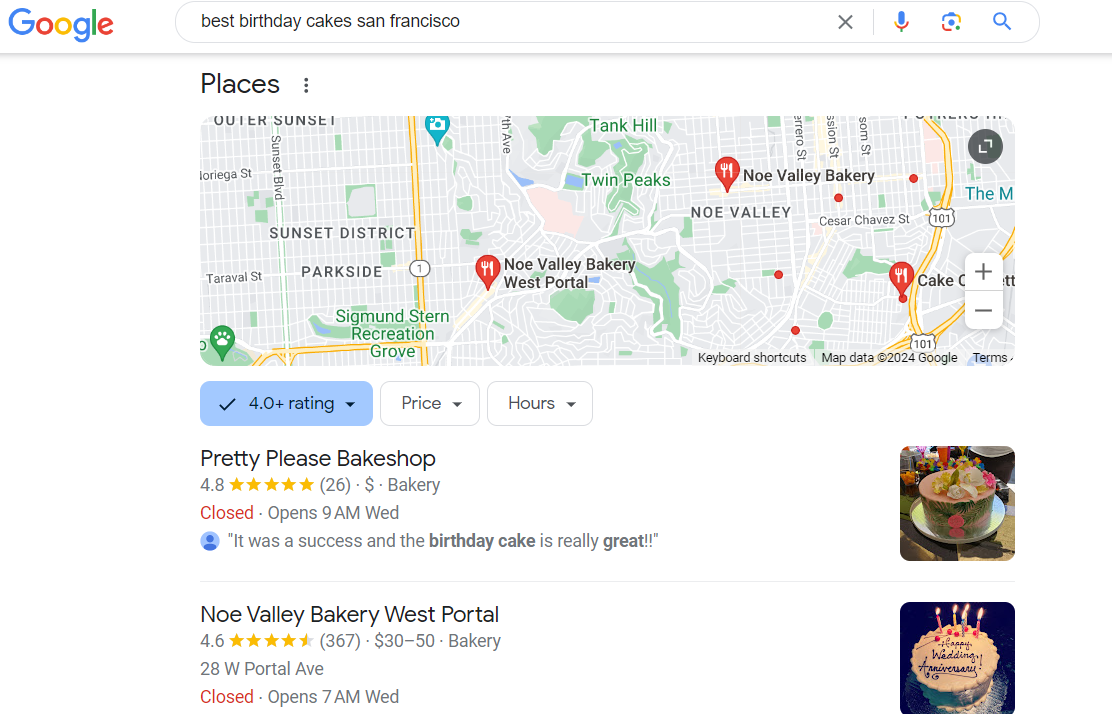
In addition to setting up a business profile, consider signing up for Google Search Console (GSC). GSC is an invaluable tool that provides a wealth of useful search data. Here’s what you can do with GSC:
- Analyze the keywords clicked: See which keywords users clicked on to land on your website. This helps you understand what your potential customers are searching for.
- View your impressions for particular keywords: Find out how often your site appears in search results for specific keywords.
- Monitor your click-through rate: Understand the percentage of users who see your site in search results and click through to visit.
- Identify top pages: Identify popular pages on your website that attract the most traffic.
- Resolve indexing issues: GSC alerts you to any problems Google has in indexing your website, enabling you to fix them promptly.
If GSC seems overwhelming, use a simple restaurant dashboard provided by your website service. These steps enhance your online presence, attract more customers, and ultimately boost your business success.
3. Show your dominance in local SEO
After creating your Google Business Profile, it’s time to increase your restaurant’s digital footprint and establish a robust online presence. Add your business information to the following online directories and review sites:
By incorporating your business information across these review sites, you reinforce your brand identity and show your restaurant’s credibility to both Google and website visitors. This multi-platform approach strengthens your online presence and becomes a strategic move against your local competitors.
A word of caution: Ensure your NAP (name, address, phone) data is consistent across all these pages because it’s an important element of your local SEO.
Remember, a strong online presence is not only about visibility; it involves providing comprehensive and accurate information that adds value to potential customers.
So, what does the Golden Rule say? The more platforms your restaurant is listed on, the higher the chances of reaching a broader audience and increasing your restaurant’s patronage.
4. Optimize your website for mobile and desktop
Did you know that 89% of dining searches are done on a mobile before customers actually dine in? When your customers are hungry, they don’t switch on their desktops to perform a Google search on nearby restaurants. Instead, they turn to their mobile devices.
And, preferably, choose a restaurant offering the best online ordering system. But on the contrary, employees working in an office use their desktops to search for nearby restaurants. So, to increase your online visibility, optimize your restaurant website for mobile and desktop.
Remember to follow these tips:
- Use responsive web design to increase your customer’s experience on mobile, desktop, and even tablet.
- Use high-resolution images that increase the aesthetic appeal and look great on mobile and desktop.
- Ensure the readability of your text. Customers will use your online ordering system. Only when they can read their menu and other pages.
- Include click-to-order buttons to allow customers to order from a single click.
Here’s how the desktop and mobile website of an Italian restaurant looks like:
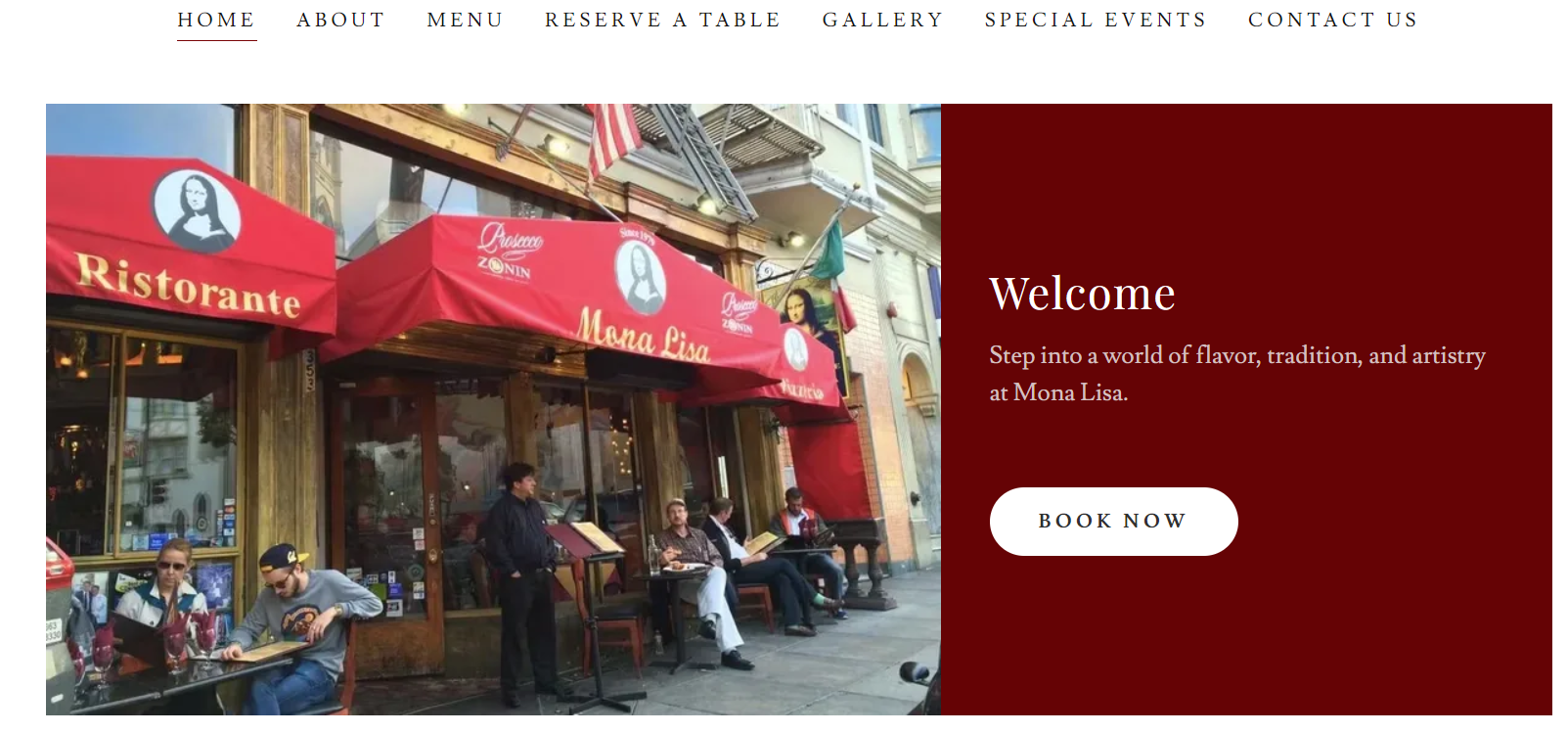
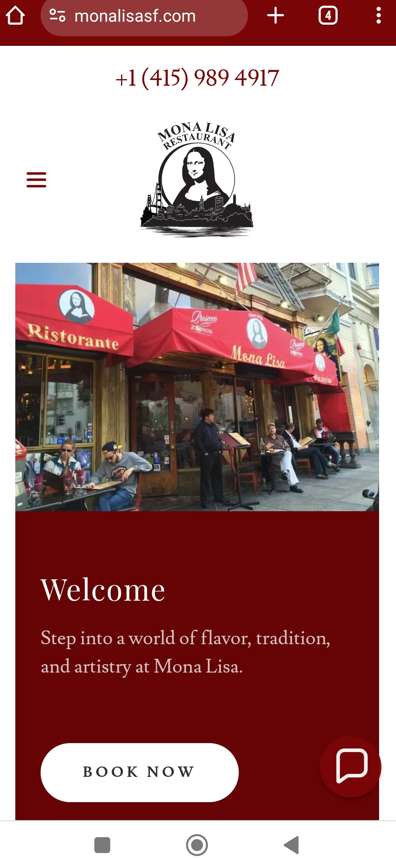
4. Use text-based menus
Before making reservations, many customers perform local search results for the food they want to eat. So, ensure your menu’s keywords rank on search engine results. Having a separate page dedicated to your menu helps you rank your menu items. However, many restaurants fall into the trap of using PDFs for their menu.
Don’t commit this mistake because Google cannot read PDF or image-based menus.
It’s always better to use a text-based menu over an image based.
As menus are the hero page of your website, ensure they’re easy to read. When users have to zoom in or zoom out to read your menu, it reduces your user experience.
Cutlets is a great example of restaurants using functional and text-based menu pages.
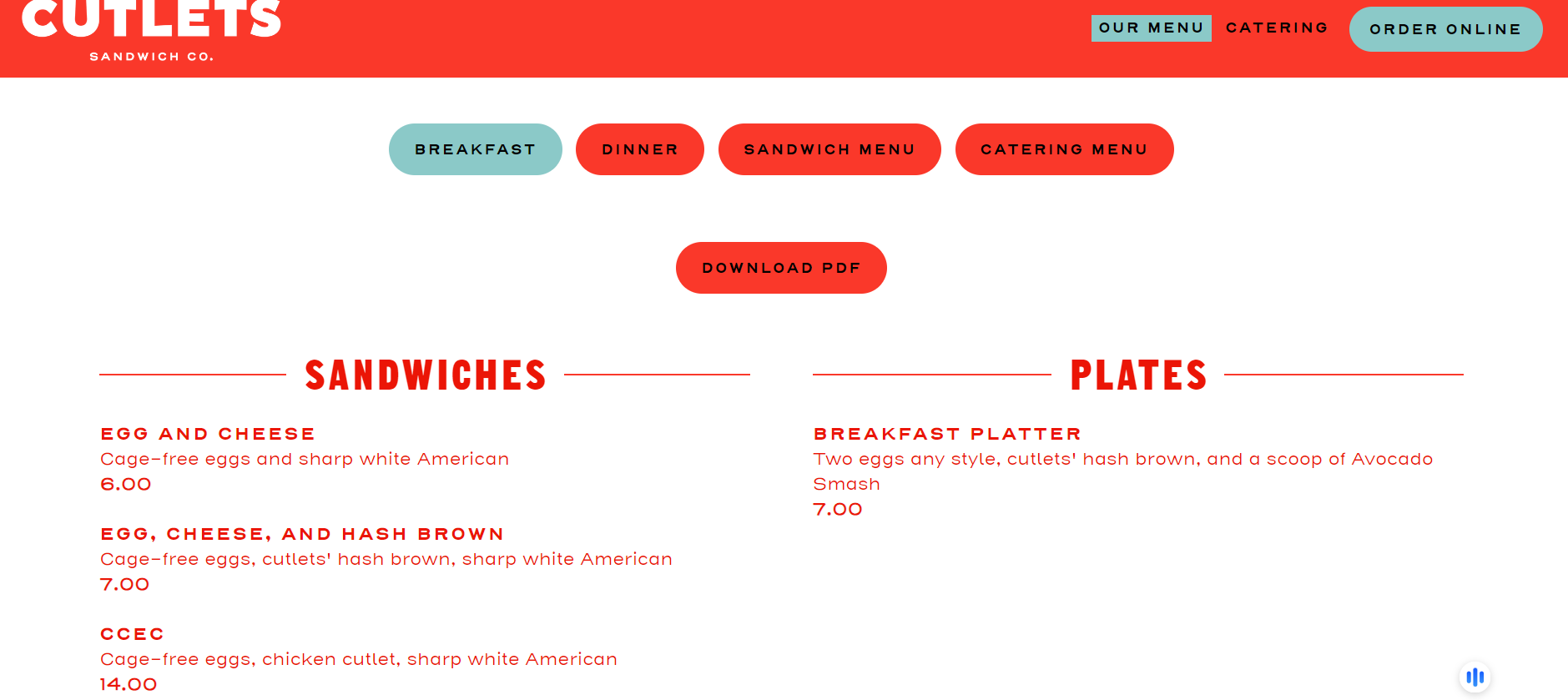
Take inspiration from it and make it a part of your marketing strategy.
5. Encourage online reviews from existing customers
Another critical step to improve your restaurant SEO and increase your online visibility is collecting customer reviews. Google measures this engagement as a degree of overall site health.
The more people talk about your business, the more Google will consider it trustworthy and include it in the top search results.
Reviews from real customers build trust and show potential customers the delicacies you offer. Plus, many high-ranking restaurant websites have a lot of reviews and a high star rating.
With 95% of customers reading online reviews before purchasing, ignoring them could turn off your potential and even existing customers.
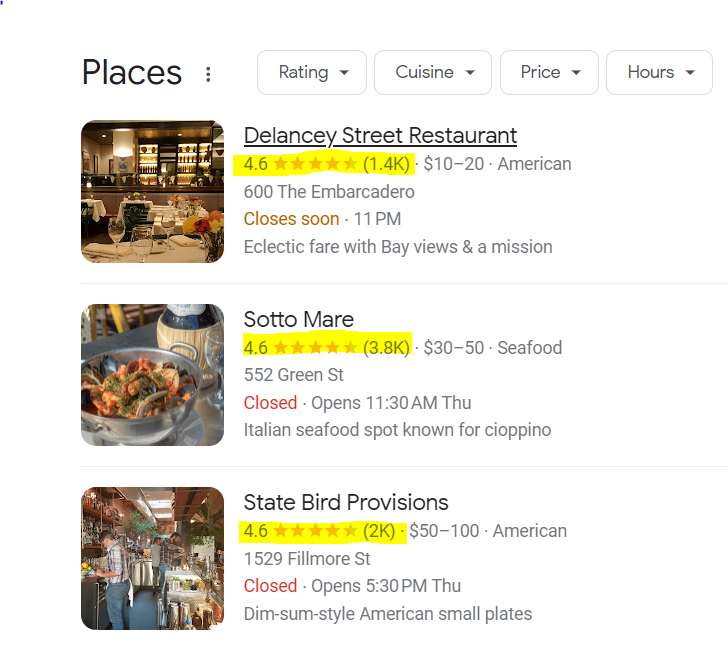
Using these ways, encourage your customers to leave reviews:
- Give them a 10-15% discount on their next visit.
- Offer a complimentary drink or beverage by leaving a review on your website.
- Print a review QR code and display it on each table.
- Give other freebies.
Respond to every online review regardless of whether your customers leave a positive, negative, or neutral review. It improves your search rankings. Why?
41% of your customers feel good about your business when you respond to your reviews.
6. Test your online ordering system
With increasing organic traffic to your website, you may have an online ordering system. While it’s important to have online ordering, ensure it’s easy for your customers to place an order. Often, customers will abandon your website if your ordering system is extremely complex and not user-friendly.
While it’s obviously a revenue loss, you lose local customers. It even hurts your search engine results, and your SEO strategy goes for a toss.
So, hire UX designers to create an interface from which customers will love ordering. Get feedback from multiple people about the look and feel of your ordering system. That way, you know whether you offer a process free from glitches and confusion.
7. Use the new kid on the block – optimize for voice search
“Hey Siri, can you tell me the best bakery in San Fransico?”
According to Yext, 39% of voice search users prefer using voice devices over smartphones, especially when looking for restaurants.
With these statistics in mind, adding content that incorporates natural language, answers frequently asked questions, and includes long-tail, conversational keywords to optimize for voice search is essential.
Include the “what,” “when,” “where,” and “how” questions your customers ask about your restaurant.
For instance, a bakery in San Fransico can optimize content using the following phrases:
- What is the best bakery restaurant near me?
- Where can I find a bakery in San Fransico?
- How much does a puff pastry at a bakery cost?
- When do bakeries close in San Fransico?
By quickly reviewing related queries, identify conversational phrases and words that customers can incorporate into their website and content.
8. Structure the information on your website
To draw customers to your restaurant, ensure the main information about your establishment is readily available on the first page of search engine results. This includes the local pack result and also knowledge graphs for brand queries.
To make your restaurant more visible on the search engine results page (SERP), employ Schema markup. This semantic vocabulary acts as a code that you add to a webpage to assist search engines in better understanding its content.
By organizing your data using Schema, you emphasize details such as your menu, which displays directly on the first SERP. Exploring the Schema tags specific to restaurants is beneficial, but ensure your titles and meta descriptions are optimized before incorporating markup.
Additionally, optimize your on-page elements like titles, descriptions, headings, and body text as they affect your click-through rates. With on-page optimization, your website becomes mobile-friendly and loads quickly.
Grow your restaurant business with SEO
An intelligent restaurant SEO strategy helps your offline restaurant thrive like never before. Mastering your SEO strategy grows your restaurant business and ensures you rank on other search engines.
If you want your restaurant to be full day in and night out, customers should know about it. Only when customers find your business online can they take action? Use these restaurant SEO tips to provide a great website experience and encourage customers to take action.

